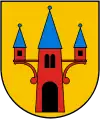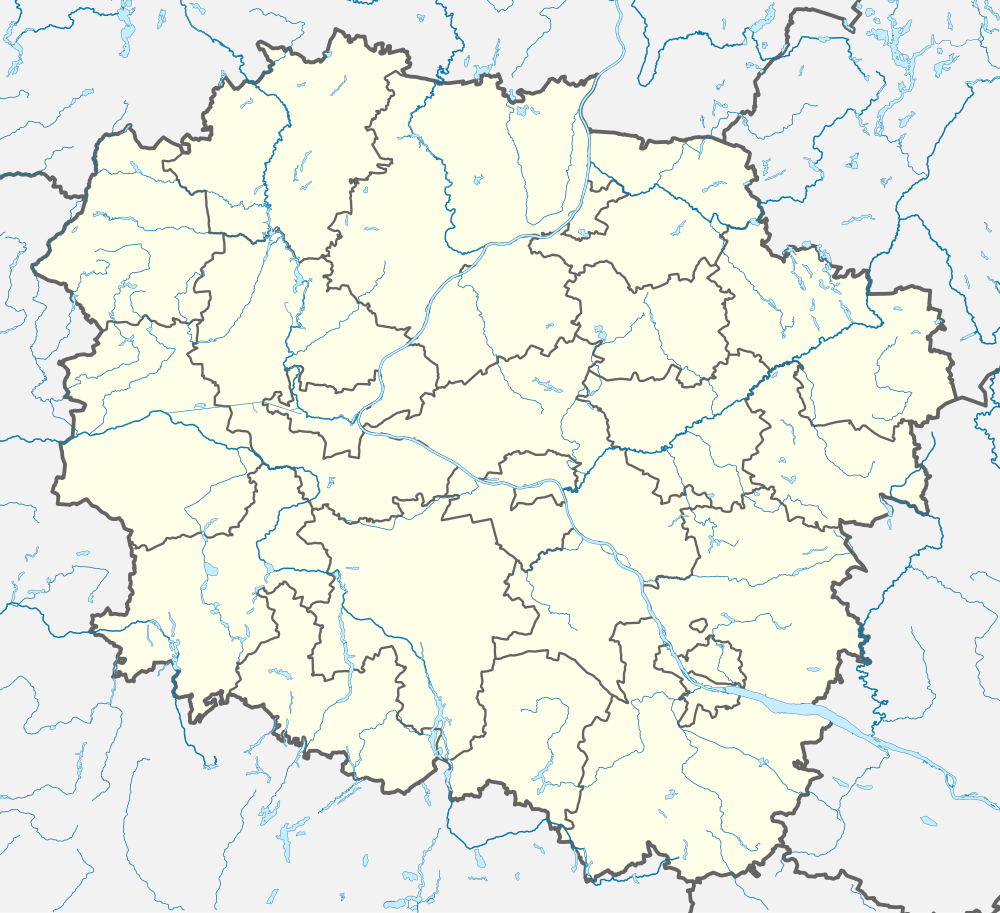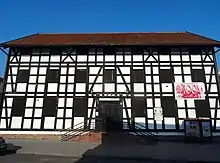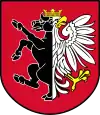Nakło nad Notecią
Nakło nad Notecią [ˈnakwɔ ˌnad nɔˈtɛt͡ɕɔ̃] (German: Nakel) is a town in northern Poland on the river Noteć (German: Netze) with 23,687 inhabitants (2007). Since 1999, it has been in the Kuyavian-Pomeranian Voivodeship. It was in Bydgoszcz Voivodeship from 1975 to 1998. It is the seat of Nakło County, and also of Gmina Nakło nad Notecią.[1]
Nakło nad Notecią | |
|---|---|
.jpg.webp) Market square | |
 Flag  Coat of arms | |
 Nakło nad Notecią  Nakło nad Notecią | |
| Coordinates: 53°8′25″N 17°35′34″E | |
| Country | |
| Voivodeship | |
| County | Nakło County |
| Gmina | Gmina Nakło nad Notecią |
| First mentioned | 11th century |
| Town rights | 1299 |
| Government | |
| • Mayor | Sławomir Napierała |
| Area | |
| • Total | 10.62 km2 (4.10 sq mi) |
| Population (2006) | |
| • Total | 19,409 |
| • Density | 1,800/km2 (4,700/sq mi) |
| Time zone | UTC+1 (CET) |
| • Summer (DST) | UTC+2 (CEST) |
| Postal code | 89-100 |
| Car plates | CNA |
| Website | http://www.naklo.pl |
History

Nakło began to develop as a Pomeranian settlement by the middle of the 10th century. It was initially called Nakieł, and its name comes from the Old Polish word nakieł.[2] The name morphed into Nakło in the 16th century.[2] The town was first mentioned in 11th-century documents.[2] Between 1109 and 1113 it fell to Duke Bolesław III Wrymouth of Poland. It received Magdeburg town rights in 1299. It was a royal town of the Polish Crown[2] and a county seat located in the Kalisz Voivodeship in the Greater Poland Province of the Polish Crown.
Nakło was annexed by the Kingdom of Prussia during the First Partition of Poland in 1772 and known by the German name Nakel. It began to develop significantly after the completion of the Bydgoszcz Canal, which connected the Vistula with the Noteć, Warta, and Oder rivers.
After the defeat of Prussia in the Napoleonic War of the Fourth Coalition, Nakło became part of the Duchy of Warsaw in 1807. After the defeat of Napoleon Bonaparte in 1815, it was restored to Prussia in the Congress of Vienna as part of the autonomous Grand Duchy of Posen.
During the course of 19th-century industrialization, Nakło developed further after being connected with the Prussian Eastern Railway in 1851. It became part of the Prussian-led German Empire in 1871. After World War I, in 1918, Poland regained independence and many inhabitants joined the Greater Poland uprising (1918–19) in aim to reintegrate the town with the reborn state.[2] The town soon became part of the Second Polish Republic according to the Treaty of Versailles.
.jpg.webp)
During the invasion of Poland, which started World War II, the German army invaded the town on September 3, 1939, and afterwards it was occupied by Nazi Germany until January 1945.[2] The German gendarmerie and the Selbstschutz carried out mass arrests of Poles in October and November 1939, and a prison for Poles was established in the local gymnasium.[3] Many Poles from Nakło, including teachers, craftsmen, merchants and children, were murdered in large massacres in the nearby village of Paterek.[4] In November 1939, the commander of the SD-EK 16 declared that all Polish intelligentsia capable of resistance had been eliminated.[5]
Sports
The local football club is Czarni Nakło. It competes in the lower leagues.
Notable residents
- Elizabeth Granowska (c. 1372–1420), Queen consort of Poland, wife of King Władysław II Jagiełło[2]
- Nathan Porges (1848–1924), rabbi
- Hermann von Strantz (1853–1936), German general
- Ignaz Jastrow (1856-1937), economist and historian
- Szczęsny Dettloff (1878–1961), historian of art
- Abraham Buschke (1868-1943), doctor
- Klemens Biniakowski (1902–1985), sprinter
- Rafał Blechacz (born 1985), classical pianist, winner of International Chopin Piano Competition
Twin towns
Gallery
 Nakło haven
Nakło haven Saint Stanislaus church
Saint Stanislaus church County office
County office Saint Lawrence church
Saint Lawrence church Katyn massacre memorial
Katyn massacre memorial General education liceum (high school)
General education liceum (high school)
See also
References
- "O mieście i gminie". Retrieved 2019-09-08.
- "Historia". Portal - Nakło (in Polish). Retrieved 5 September 2020.
- Maria Wardzyńska, Był rok 1939. Operacja niemieckiej policji bezpieczeństwa w Polsce. Intelligenzaktion, IPN, Warszawa, 2009, p. 163 (in Polish)
- Wardzyńska, p. 163-164
- Wardzyńska, p. 160
- "Miasta partnerskie". Retrieved 2019-09-08.
| Wikimedia Commons has media related to Nakło nad Notecią. |
